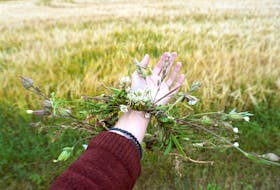DIGBY, N.S. – Whenever Jonathan Riley heads out on a hike, it’s usually an adventure.
And on this particular day – a Sunday in early August – he could have hiked just about anywhere.
This way. That way.
That way. This way.
“I could have chosen a million other things to do that day, but I thought, ‘Oh, I’ll just do that walk,” he says.

“That walk” took the Digby resident (and yes, a former reporter with this newspaper) to what he calls a “weird little spot” on the coastline. A walk that would take him from Prim Point to the Shipwreck monument, and then even beyond that where he’d be challenged by terrain. An eventual place that he says you can’t get to unless it’s low tide, with what he calls two “pinch points” that make the hike even harder.
“It’s the kind of place no one goes to because you can only get through there at low tide and it’s an hour-and-a-half from anywhere,” he says. “It’s very rare but I thought, I’m going to make that walk.”
Kathleen Martin is thankful that he did.
Well, thankful and sad.
Because on his walk Riley discovered a dead leatherback sea turtle. And not just any turtle, but one of the most significant ones that the Canadian Sea Turtle Network has researched and tracked over the years.
Later that day Riley called the network to report his finding. When Martin searched the turtle from the tag numbers that Riley had given her, her heart sank. The turtle was Red Rockette.
Red Rockette has offered researchers valuable insight into leatherback sea turtles, even though science still has much to learn about this endangered species, Martin says.
“One of the things that is important to keep remembering is sea turtle science is really new in this country,” she says. “The bulk of it is about 20 years old and when you’re looking at a species, this is a dinosaur, this species has been here for over 150 million years, we know so little.”
“We are absolutely students of these animals,” she says. “So all of them are important. The information is important. Calling is important when we see them, taking pictures if you see them, if you find a dead one it’s really important that we know.”

Red Rockette had been tagged off Nova Scotia in 2012. In March 2013, the turtle gained notoriety and popularity when it was tracked from Nova Scotia to Colombia, “winning” the Great Canadian Turtle Race as part of 10 leatherback sea turtles whose journeys in the ocean were being tracked. This turtle eventually nested on a beach called Bobalito in Colombia.
Red Rockette was discovered again by scientists in waters off Cape Breton in 2014. And then again back on Bobalito beach in 2016.
Martin says this is nothing short of astonishing.
“Plucking an animal out of the vast Atlantic Ocean? People that live on the ocean get it, it's a very, very big body of water,” she says. “You’re pulling it out of the ocean not once, but twice . . . and it was found on the beach twice and it’s washed up in the remotest of locations, not even where we usually find leatherbacks, and we don’t usually find them along the Fundy coast.”
It’s not known exactly how old the turtle was – Martin says it is difficult to pinpoint the age of a leatherback turtle. This adult female’s shell was about a metre-and-a-half long and it’s believed she was a couple decades old. Perhaps.
Martin says losing this particular turtle really puts the work they do in perspective because it isn’t an easy feat to gather information. Again, it’s why reported sightings are so important to researchers.
She says all of the encounters with Red Rockette have left her wondering: “What are we supposed to know that we don’t already know? It’s one of those things when you keep saying, ‘Tell me more, nature. Tell me more.’”
When Riley found Red Rockette, the turtle was quite decomposed, and it smelled horrible. Oddly enough, just a week earlier a friend, Ralph Cummings, had asked Riley if he had ever seen a leatherback turtle. He had shown Riley a video that someone had taken of a leatherback in the water. Riley had never seen one – but then did a week later. “That was the thing, for me, that was the craziest,” he says.

When he called the network and spoke to Martin, she asked him if he actually had the turtle’s tags. He hadn’t taken them, noting he had to brush flies off the turtle just to take the photos of the tags in the first place.
Martin asked if he would be willing to go back for the tags. And so Riley did. (If you know Jonathan, this doesn’t surprise you.)
Martin says the Department of Fisheries and Oceans later tapped into its resources to remove the turtle so a necropsy could be performed to try to determine how and why it died. It took a boat, a forklift and a boom truck to get the turtle from point A to point B after it was “floated out.”
Leatherback turtles, aside from being very large, are very heavy. Martin says they can weigh upwards of 900 to 1,000 pounds.
“We just don’t know what we’re going to learn from each one,” she says, sad about this loss but ever grateful to the random hike that Riley took. “He was a superstar in this case because this is such an important turtle to us.”
Reporting turtle sightings
The Canadian Sea Turtle Network asks that if you see a live or dead sea turtle to call it immediately on its toll-free turtle hotline at 1-888-729-4667 to report the sighting. Calls can be taken 24 hours a day, seven days a week. To submit details of your sighting, a form is also available on the website.
Sea Turtle Beach Patrol
Kayla Hamelin, assistant director Conservation and Education, Canadian Sea Turtle Network, says over the years a number of stranded turtles have been found in this region.
“Although we have been successful in contributing new information that is crucial to the conservation of the leatherback sea turtle, we still know very little about how frequently smaller, ‘hard-shelled’ types of sea turtles that enter our coastal waters,” she says. “These other species of sea turtles typically prefer warmer waters than those around coastal Nova Scotia, but on rare occasions we find cold-stunned green turtles, Atlantic Ridley turtles, and loggerhead sea turtles stranded on our beaches in the fall.”
The network’s new Sea Turtle Beach Patrol volunteer project aims to put a dedicated effort into searching for sea turtles that wash up on beaches, in the hope of better understanding the frequency and distribution of these animals.
“We accept volunteers from coastal communities around the Canadian Maritimes to monitor their local beaches for stranded animals from October through December,” Hamelin says.
To get involved visit: www.seaturtle.ca/beach-patrol.
5 things to know about Leatherback Sea Turtles
1. The Leatherback Sea Turtle is 1 of 7 species of marine turtles in the world. It evolved around 100 million years ago and co-existed with the dinosaurs.
2. The species is named for its characteristic leathery shell, which differs from the bony shells of the other 6 marine turtle species.
3. The adult Leatherback Sea Turtles that frequent Atlantic Canadian waters have an average curved carapace (shell) length of approximately 1.5 metres and an average weight of approximately 400 kg. (800 lbs)
4. The throat and esophagus in a Leatherback Sea Turtle are covered with spines, which are believed to be an adaptation to assist in swallowing slippery jellyfish prey.
5. An adult female can lay between 60 and 90 eggs at a time and may nest up to 10 times a season.
READ OUR COLLECTION OF THEN AND NOW STORIES
• Tiny house, big view: New home, old soul in Cape Forchu, Yarmouth County CLICK HERE
• Random Digby County find leads to huge loss in leatherback sea turtle research CLICK HERE
• Sam Langford’s story ‘Chasing Champions’ coming to the Marc Lescarbot Theatre as his legacy lives on CLICK HERE
• Celebrating Yarmouth area’s sports history CLICK HERE
• Running shoes, equipment, have come a long way CLICK HERE
• ‘I wanted to keep it here for everyone to enjoy’ – New life for historic Robertson building in Barrington Passage CLICK HERE
• Historic Milton horse returns to Yarmouth for its perch back on 1893 fountain CLICK HERE
• How a 1963 fire reshaped a streetscape in downtown Yarmouth CLICK HERE
• Rural internet efforts continue as travel the information highway in southwestern Nova Scotia CLICK HERE
• ‘I love upholding the tradition’ – 1880 history lives on at Shelburne Dory Shop CLICK HERE
• What was it? Shared story of September daytime UFO sighting in Cape Sable Island has people talking CLICK HERE
• Electric City: ‘We may not have everything we started out with, but we still have the story’ CLICK HERE
• COLUMN: Laurent d’Entremont: Turning back the clock to my childhood days CLICK HERE
MORE TO COME….







